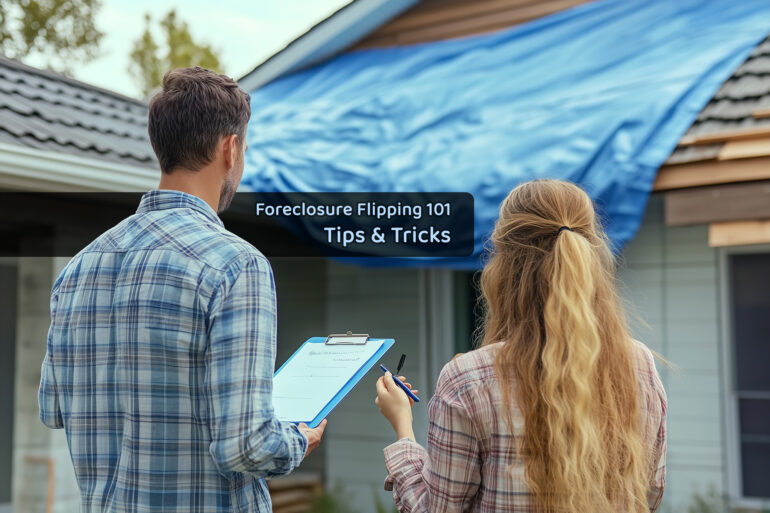Foreclosure Flipping 101: Tips and Tricks to Profit from Distressed Property
Buying and flipping foreclosure real estate can be profitable if you understand the risks. You’ll take something neglected and restore it to its original glory. You can also enter the flipping arena at a lower upfront cost than buying a home in turnkey condition.
Before investing your life savings into a foreclosed home that you plan to flip, learn the market. Even buying foreclosed homes at auctions or for a discount can eat into your budget if you make poor choices. Learn from those who’ve been in the business a while and know what works.
Tips and Tricks for Flipping Distressed Properties
Attom’s May 2024 U.S. Foreclosure Market Report shows a 3% increase in foreclosure filings compared to the end of 2023, with over 32,000 properties foreclosed in March. Finding distressed properties to buy is the easiest part of the process. Figuring out if they’re worth your time and money requires careful consideration.
Flipping foreclosed properties can be somewhat straightforward. While you often only see the outside until purchase and may encounter unexpected issues, some basic calculations can help determine if the house has potential.
Driving by the foreclosure can also tell you a lot about the neighborhood.
1. Drive By
Gather your list of distressed properties and drive past them. Be careful not to trespass, but you can view the residence from the sidewalk. Pay particular attention to details, such as how old the roof looks, whether fencing needs to be replaced and what shape the concrete is in. These all add to your renovation costs. Will you have to do a complete landscaping job, or does it only need to be cleaned up?
You can also see things, such as what the outside looks like. If it’s particularly dated and looks like it’s from a bygone era, you may also need to budget for exterior upgrades. While the outside can hint at the potential disrepair inside, be aware that you can, sometimes, have a neat outer shell with a trashed interior and vice versa.
Driving by the foreclosure can also tell you a lot about the neighborhood. If the next-door neighbor has a car on blocks and weeds are growing out of another abandoned vehicle, it can harm the property value. If most houses on the street are well maintained, it can increase value.
2. Pull Details from Property Records
Many counties offer property records that you can look up by name or address. Go to your county government website and see if these are readily available. Sometimes, you must go to the courthouse and look at paper records.
Some advantages of spending additional time to track down property records include knowing the floor plans if the original owner submitted them and getting details on the land around the property that you may not be able to view from the street.
3. Assume HVAC Replacement
The average heater and air conditioner lasts 15 to 20 years, with 50% of efficiency lost at the 10-year mark. If the home sat empty, the HVAC likely wasn’t maintained properly, which can shorten the life of the equipment. It’s best to budget for a replacement. If you purchase a foreclosure and the air or heating still has enough life to warrant keeping it, you’ll have additional funds to spend elsewhere.
Squatters’ rights exist in all 50 states in the country. However, each has different laws and rules regarding adverse possession.
4. Estimate Renovations
Suppose the property’s interior is a mystery. You can use general guidelines of what repairs would cost per square foot in your area versus the after-repair value (ARV) to determine if the project is viable.
Estimate the selling price of renovated homes of the same size in the area. Subtract the planned purchase price and the amount you think renovations will run to determine if the profit margin is worth your time. Most investors also add a slight buffer in case they run into significant structural issues.
Research and number crunch before the foreclosure auction or tax lien sale. Know how high you can go with your bid and still make money. A good rule of thumb is to pay 70% or less of the home’s ARV minus renovation costs.
Real Estate Rehab Cost Calculator
Use this calculator to quickly estimate rehab costs for your property investment.
Estimated Rehab Cost:
Breakdown:
Calculator disclaimer: Estimates are based on general averages and may not reflect exact costs for your specific project.
5. Check for Signs of Squatters
Getting squatters out of a home can cost you time and money. Although trespassing may be considered criminal, most localities treat squatting as a civil matter. You must go to court and have anyone living in the home removed through eviction. If the court cases are backed up or the person asks for continuances, it could take months to remove them, costing you cash.
Squatters’ rights exist in all 50 states in the country. However, each has different laws and rules regarding adverse possession.
In Florida, squatters aren’t protected by landlord-tenant regulations. A recent legislation change with HB 621 puts the power back into the hands of property owners. The law gives owners the right to request local law enforcement immediately move the person for trespassing. Criminal charges can be filed if the person caused property damage or falsified documents.
By comparison, Ohio forces property owners to take squatters to court by serving an eviction notice. Removing people usually takes around 30 days, so renovations must wait. When flipping homes, time means money. You may even have a crew on standby who you must pay while you wait to regain possession of the house.
Ohio has introduced two new bills similar to Florida’s law. Both aim to give property owners some relief.
Pay attention to any trash cans at the curb or signs of wrappers and bags around the property. Broken windows or torn-down boards may indicate someone is living in the home. Sometimes, small fires glow at night in cooler weather as most foreclosed homes lack electricity.
Flipping foreclosures is different from buying conventional real estate.
6. Team up With Real Estate Professionals
Finding comparable properties and estimating potential value is much easier if you hire a real estate agent and get their input about neighborhoods. They’ll know which areas are most desirable to families because of an excellent school system. An experienced agent also knows which locations sell quickly, allowing you to flip the property and move on to the next project.
Another benefit of finding a connection in real estate is that they will know repair people and construction professionals and can help you gain access to people who work efficiently.
7. Create a Budget
Make a list of all the potential costs. You’ll have more expenses than just the repairs. You’ll also likely have to pay liens, taxes while conducting repairs, deposits to hook up utilities, and lawn care for several months.
You also have to know what designs are trending, so you can invest in the right colors and styles for the interior. If you plan to hire a staging company, budget accordingly. Finally, you’ll have marketing costs to get the word out about the home. If you sell through a real estate agent, a percentage of the sale price goes to them, decreasing your profits.
Learn as You Go
Flipping foreclosures is different from buying conventional real estate. You’ll need cash to bid against other investors and a network of professionals to complete the work quickly. Even after renovations, you must get the word out that the house is for sale and find the right buyers. Still, if you learn as you go and correct your mistakes, you’ll find foreclosure flipping rewarding and profitable.








